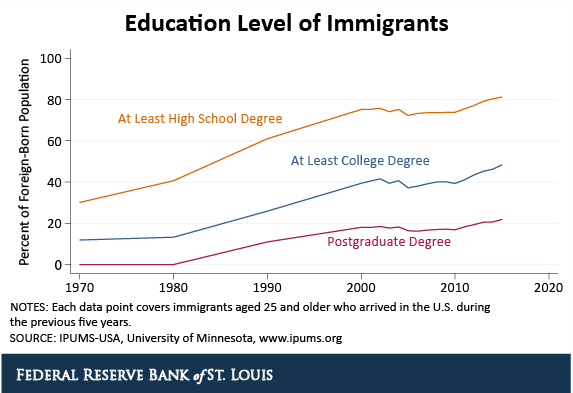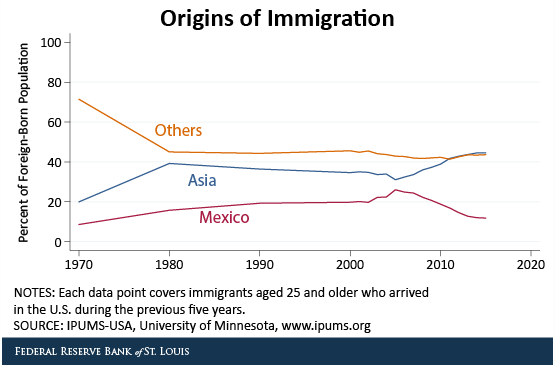Today’s Immigrants Are More Educated than 50 Years Ago
Today’s immigrants to the U.S. are substantially more educated than 50 years ago.1 The figure below shows the evolution of the level of education for newly arrived immigrants to the U.S. within the past five years.

In 1970, 30.1 percent of newly arrived immigrants had at least a high school degree. By 2015, the fraction had increased to 81.3 percent.
Similarly, the share of newly arrived immigrants with at least a college degree had increased from 11.9 percent to 48.3 percent and a postgraduate degree from 0 to 21.9 percent. The figure shows that the increase in the level of education of newly arrived immigrants accelerated in the mid-2000s.
Increase in Education Level of Immigrants
What accounts for the rapid increase in the level of education of newly arrived immigrants? A study by the Pew Research Center suggests that the change in composition of origin of new immigrants may be one explanation behind this trend.3
A slowdown in immigration from Mexico accompanied by a rise in immigration from Asia in the 2000s may explain why today’s immigrants are much more educated than those from the 1970s.2 The figure below shows that the share of newly arrived immigrants from Mexico decreased from 26.0 percent in 2005 to 11.8 percent in 2015, versus an increase in the share of newly arrived immigrants from Asia from 31.1 percent to 44.5 percent over the same period.

However, the change in the composition of origin cannot be the only explanation. The first figure shows that the level of education of newly arrived immigrants experienced a sharp increase after the mid-2000s, yet a steady increase was already occurring from the 1970s.
We hence propose that the steady increase may also be driven by an increase in the level of education of immigrants of all origins since the 1970s. The table below reports the share of immigrants from Mexico and Asia who hold:
- At least a high school degree
- At least a college degree
- A postgraduate degree
| Mexico | Asia | |||
| 1970 | 2015 | 1970 | 2015 | |
| At Least a High School Degree | 7.0% | 49.6% | 59.2% | 87.5% |
| At Least a Bachelor’s Degree | 2.2% | 15.5% | 28.4% | 62.4% |
| Postgraduate Degree | 0.0% | 4.3% | 0.0% | 28.4% |
| SOURCE: IPUMS-USA, University of Minnesota, www.ipums.org. | ||||
We observe two facts:
- On average, a higher fraction of newly arrived immigrants from Asia had at least a high school degree, at least a college degree and a postgraduate degree than those immigrants arriving from Mexico.
- Both Mexicans and Asians arriving to the U.S. in 2015 were more educated than those who arrived in 1970.
Hence, both groups have experienced an important increase in the level of education. Therefore, the fact that newly arrived immigrants across all origins are more educated on average in 2015 than in the 1970s—coupled with an increased share of immigrants from Asia, who are more educated on average than other groups—helps explain the increase in the level of education of newly arrived immigrants to the U.S. since the 1970s.
Notes and References
1 Fry, Richard. “Today’s Newly Arrived Immigrants Are the Best-Educated Ever.” Pew Research Center. Oct. 5, 2015.
2 Santacreu, Ana Maria. “Reflections on Net Migration” The FRED Blog, Federal Reserve Bank of St. Louis. July 24, 2017.
3 “Modern Immigration Wave Brings 59 Million to U.S., Driving Population Growth and Change Through 2065: Chapter 3: The Changing Characteristics of Recent Immigrant Arrivals Since 1970.” Sept. 28, 2015.
Additional Resources
- On the Economy: Does Immigration Affect Local Labor Markets?
- On the Economy: Immigration: Top Origin Nations and Top Destinations
- On the Economy: Where Are Immigrants to the U.S. Coming From?
Citation
Ana Maria Santacreu and Heting Zhu, ldquoToday’s Immigrants Are More Educated than 50 Years Ago,rdquo St. Louis Fed On the Economy, Aug. 27, 2017.
This blog offers commentary, analysis and data from our economists and experts. Views expressed are not necessarily those of the St. Louis Fed or Federal Reserve System.
Email Us
All other blog-related questions



